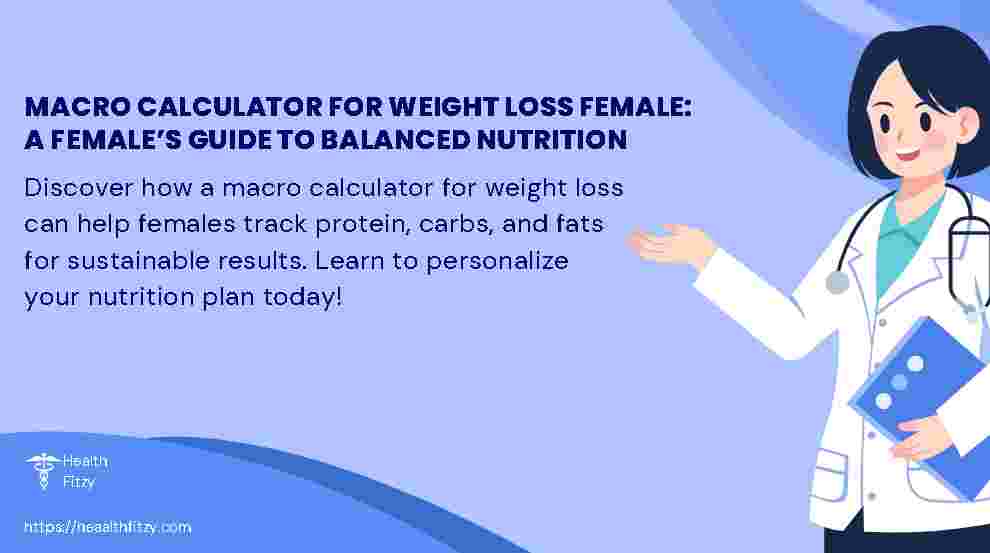Macro Calculator for Weight Loss female: A Female’s Guide to Balanced Nutrition
Losing weight as a female involves more than just counting calories—it’s about fueling your body with the right nutrients. A macro calculator for weight loss female is a personalized tool designed to help you determine your optimal intake of macronutrients (protein, carbohydrates, and fats) based on your age, weight, activity level, and goals. In this guide, we’ll explain how macros impact weight loss, how to use a macro calculator effectively, and actionable tips to stay on track.
Why Macros Matter for Female Weight Loss
Macronutrients (macros) are the building blocks of your diet and directly influence energy levels, metabolism, and body composition. For women, balancing macros is crucial due to hormonal fluctuations, muscle preservation, and metabolic needs. Here’s why tracking macros works:
-
Protein: Sincreases metabolism, lessens cravings, and aids in muscle regeneration. (aim for 1.2–2.2g per kg of body weight).
-
Carbohydrates: Provide energy for workouts and brain function (prioritize complex carbs like oats and quinoa).
-
Fats: Essential for hormone production and nutrient absorption (focus on healthy fats like avocados and nuts).
A macro calculator tailors these ratios to your unique needs, ensuring you stay in a calorie deficit without feeling deprived.
How to Use a Macro Calculator for Weight Loss
Step 1: Calculate Your Total Energy Use Each Day
Your TDEE is the number of calories you burn daily, including exercise. Most calculators use the Mifflin-St Jeor equation to estimate this based on your age, weight, height, and activity level.
Step 2: Set Your Weight Loss Goal
Aim for a modest deficit (10–20% below TDEE) to lose 0.5–1 lb per week. Extreme deficits can disrupt hormones, especially in women.
Step 3: Calculate Your Macros
A typical macro split for female weight loss is:
-
Protein: 30–40% of calories
-
Carbs: 30–40% of calories
-
Fats: 20–30% of calories
For example, a 1,500-calorie diet might include 113g protein, 113g carbs, and 50g fat daily.
Benefits of Tracking Macros for Women
-
Hormonal Balance: Adequate fats support estrogen and thyroid function.
-
Preserves Muscle: High protein intake prevents muscle loss during weight loss.
-
Flexibility: Enjoy diverse foods while staying within your macro goals.
-
Sustainable Results: Avoid the “yo-yo dieting” cycle by focusing on nourishment.
Tips to Optimize Your Macro-Based Diet
-
Meal Prep: Plan meals around lean proteins, fiber-rich carbs, and healthy fats.
-
Hydrate: Drink water to curb false hunger signals.
-
Track Progress: Use apps like MyFitnessPal or Cronometer to log macros.
-
Adjust as Needed: Recalculate macros every 4–6 weeks as you lose weight.
Common Mistakes to Avoid
-
Ignoring Fiber: Low-carb diets can lead to constipation—add veggies and whole grains.
-
Underestimating Portions: Use a food scale for accuracy.
-
Skipping Rest Days: Adjust macros on less active days to avoid overeating.
Final Thoughts
A macro calculator for weight loss female simplifies nutrition by turning abstract goals into actionable numbers. By prioritizing protein, balancing carbs and fats, and tracking your intake, you can achieve sustainable weight loss while maintaining energy and health. Always pair your plan with strength training and consult a dietitian for personalized advice.
Start today: Input your stats into a trusted macro calculator, and take the first step toward a healthier, stronger you!
This content is written for informational purposes only and is not a substitute for professional medical advice. Always consult a healthcare provider before starting a new diet or fitness program.
Pro Physique Macro Calculator: Your Ultimate Guide to Personalized Nutrition
Achieving fitness goals like muscle gain, fat loss, or improved athletic performance requires more than just hard workouts—it demands precise nutrition. The Pro Physique Macro Calculator is a powerful tool designed to help you calculate your ideal macronutrient intake (protein, carbs, and fats) based on your unique body metrics, activity level, and objectives. In this guide, we’ll explain how this calculator works, why tracking macros matters, and how to use it to fuel your fitness journey.

Why Tracking Macronutrients Matters for Your Physique
The foundation of your diet is made up of macronutrients, or macronutrients.. Protein supports muscle repair, carbohydrates fuel energy, and fats aid hormone production. Without the right balance, even the most disciplined workout routines can fall short.
The Pro Physique Macro Calculator eliminates guesswork by providing science-backed macro targets tailored to your:
-
Body composition (weight, height, age, gender)
-
Activity level (sedentary, moderate, or intense exercise)
-
Fitness goals (bulking, cutting, or maintenance)
By aligning your diet with these metrics, you can optimize metabolism, enhance recovery, and accelerate progress.
How the Pro Physique Macro Calculator Works
This tool uses proven formulas like the Harris-Benedict equation or Mifflin-St Jeor formula to estimate your Total Daily Energy Expenditure (TDEE). From there, it adjusts your macros based on your goals:
-
Weight Loss: Creates a calorie deficit while prioritizing protein to preserve muscle.
-
Muscle Gain: Recommends a calorie surplus with higher carbs/protein for growth.
-
Body Recomposition: Balances macros to lose fat and gain muscle simultaneously.
For example, a 30-year-old active male aiming to build muscle might receive a split like:
-
Protein: 35% (1.6–2.2g per kg of body weight)
-
Carbs: 45% (to fuel workouts)
-
Fats: 20% (for hormonal health)
Benefits of Using the Pro Physique Macro Calculator
1. Personalized Nutrition Planning
Generic diet plans often fail because they ignore individual differences. This calculator customizes recommendations to your lifestyle and biology.
2. Simplifies Meal Prep
Knowing your macros makes grocery shopping and meal prepping easier. Apps like MyFitnessPal can track your intake against the calculator’s targets.
3. Supports Long-Term Sustainability
Unlike restrictive diets, macro tracking focuses on balance, allowing flexibility while keeping you accountable.
4. Data-Driven Adjustments
Regularly input updated weight/activity data to refine your plan as your body changes.
How to Use the Pro Physique Macro Calculator Effectively
-
Input Accurate Data: Measure your weight, body fat percentage (if possible), and activity level honestly.
-
Set Realistic Goals: Aim for gradual changes (e.g., losing 0.5–1kg weekly) to avoid burnout.
-
Track Consistently: Use a food scale and tracking app for precision.
-
Adjust as Needed: Recalculate macros every 4–6 weeks or after significant weight changes.
Final Tips for Maximizing Results
-
Prioritize Whole Foods: Hit your macros with nutrient-dense meals (lean proteins, complex carbs, healthy fats).
-
Stay Hydrated: Water aids digestion and metabolism.
-
Combine with Training: Pair your macro plan with resistance training for best results.
Conclusion
The Pro Physique Macro Calculator is more than a tool—it’s a roadmap to smarter nutrition. Whether you’re an athlete, bodybuilder, or fitness enthusiast, understanding your macros empowers you to take control of your physique. Start by calculating your targets today, stay consistent, and watch your progress unfold.
How to Use a Macro Calculator for Muscle Gain
Achieving muscle gain requires a strategic approach to nutrition. A macro calculator helps women balance protein, carbohydrates, and fats to fuel workouts, enhance recovery, and optimize muscle growth. Here’s how to use one effectively:

Step-by-Step Guide to Using the Macro Calculator
-
Select Your Measurement Units
Choose between metric (kg, cm) or imperial (lbs, inches) to input your height and weight. -
Set Your Goal to “Muscle Gain”
This prioritizes higher protein intake to support muscle repair and growth. -
Enter Personal Details
Input your age, weight, height, and activity level. These factors determine your basal metabolic rate (BMR) and calorie needs. -
Specify Resistance Training Frequency
Indicate how often you lift weights. More frequent training increases protein and carb needs for recovery and energy. -
Adjust Carb/Fat Preferences (Optional)
Tailor ratios based on your energy preferences. For example, choose higher carbs for intense workouts or fats for sustained energy. -
Click “Calculate” for Custom Targets
Receive personalized calorie and macronutrient goals to build muscle without excess fat.
Understanding Macros
Macronutrients (carbs, protein, fats) are essential for energy, muscle growth, and overall health:
-
Carbohydrates
-
Primary energy source for workouts.
-
Opt for complex carbs (oats, quinoa) for steady energy and fiber.
-
-
Protein
-
Crucial for muscle repair and growth. Aim for 1.4–1.6g per kg of body weight daily.
-
Sources: Chicken, eggs, Greek yogurt, legumes.
-
-
Fats
-
Support hormone production and nutrient absorption.
-
Prioritize unsaturated fats (salmon, chia seeds, avocado).
-
Why Track Macros?
-
Precision: Ensures adequate protein intake for muscle synthesis.
-
Balance: Avoids excess calories while fueling workouts.
-
Sustainability: Reduces hunger with nutrient-dense foods, making long-term adherence easier.
Macros vs. Calories: Key Differences
-
Calories measure total energy intake.
-
Macros reveal food composition. For example:
| Food (100g) | Calories | Protein | Carbs | Fats |
|---|---|---|---|---|
| Grilled Chicken | 165 | 31g | 0g | 3.6g |
| Fried Chicken | 353 | 32g | 16g | 18g |
The grilled option offers lean protein, while fried chicken adds excess fats and carbs.
Top Foods for Muscle Gain
-
Protein: Chicken breast, salmon, eggs, tofu.
-
Carbs: Sweet potatoes, brown rice, oats.
-
Fats: Avocado, nuts, olive oil, flaxseeds.
Recommended Macro Ratios
Adjust ratios based on your goal:
-
Lean Muscle Gain (Minimal Fat Gain)
-
Protein: 40%
-
Carbs: 30%
-
Fats: 30%
-
-
Bulking Phase (Rapid Muscle Gain)
-
Protein: 30–35%
-
Carbs: 40–50%
-
Fats: 20–30%
-
Age Considerations
Metabolism and muscle mass decline with age. Women over 30 should:
-
Prioritize protein (1.6–2g/kg) to combat muscle loss.
-
Strength train regularly to maintain bone density.
-
Monitor calories to avoid excess fat storage.
Final Tips
-
Use a food-tracking app to log macros.
-
Recalculate goals every 4–6 weeks as progress occurs.
-
Pair nutrition with progressive strength training for best results.
By tailoring macros to your needs, you’ll fuel muscle growth efficiently while staying energized and healthy. Always consult a healthcare provider before starting new dietary plans.
What Is a Chipotle Macro Calculator?

A Chipotle macro calculator is a digital tool designed to estimate the macronutrients (protein, carbs, fats) in your customized Chipotle order. Whether you’re meal-prepping for weight loss, muscle gain, or maintaining a balanced diet, this calculator simplifies tracking by breaking down the nutritional value of each ingredient. By inputting your burrito, bowl, or salad components, you get instant insights to align meals with your health goals.
How to Use the Chipotle Macro Calculator
Start by visiting Chipotle’s official nutrition calculator or a trusted third-party app. Select your base (rice, salad, etc.), protein, toppings, and extras. The tool auto-calculates macros per serving. For example, a bowl with chicken, brown rice, black beans, and fajita veggies provides roughly 35g protein, 70g carbs, and 12g fat. Adjust ingredients to meet your targets—swap white rice for cauliflower rice to reduce carbs or add guacamole for healthy fats.
Why Track Macros with Chipotle?
Chipotle’s build-your-own model pairs perfectly with macro tracking. The calculator promotes mindful eating without sacrificing flavor. Athletes can prioritize protein, keto dieters minimize carbs, and everyone stays informed about portion sizes. Plus, it eliminates guesswork, helping you make consistent progress.
Tips for Macro-Friendly Chipotle Orders
-
Double up on grilled chicken or steak for protein.
-
Skip sour cream and cheese if reducing saturated fats.
-
Add veggies like romaine lettuce or peppers for fiber.
Final Thoughts
A Chipotle macro calculator turns fast-casual dining into a strategic part of your nutrition plan. Optimize your next order and enjoy delicious meals that fit your macros!
Read more…
First Two Weeks of the South Beach Diet Menu: Your Ultimate Guide to Success
First Two Weeks of the South Beach Diet Menu: Your Ultimate Guide to Success



